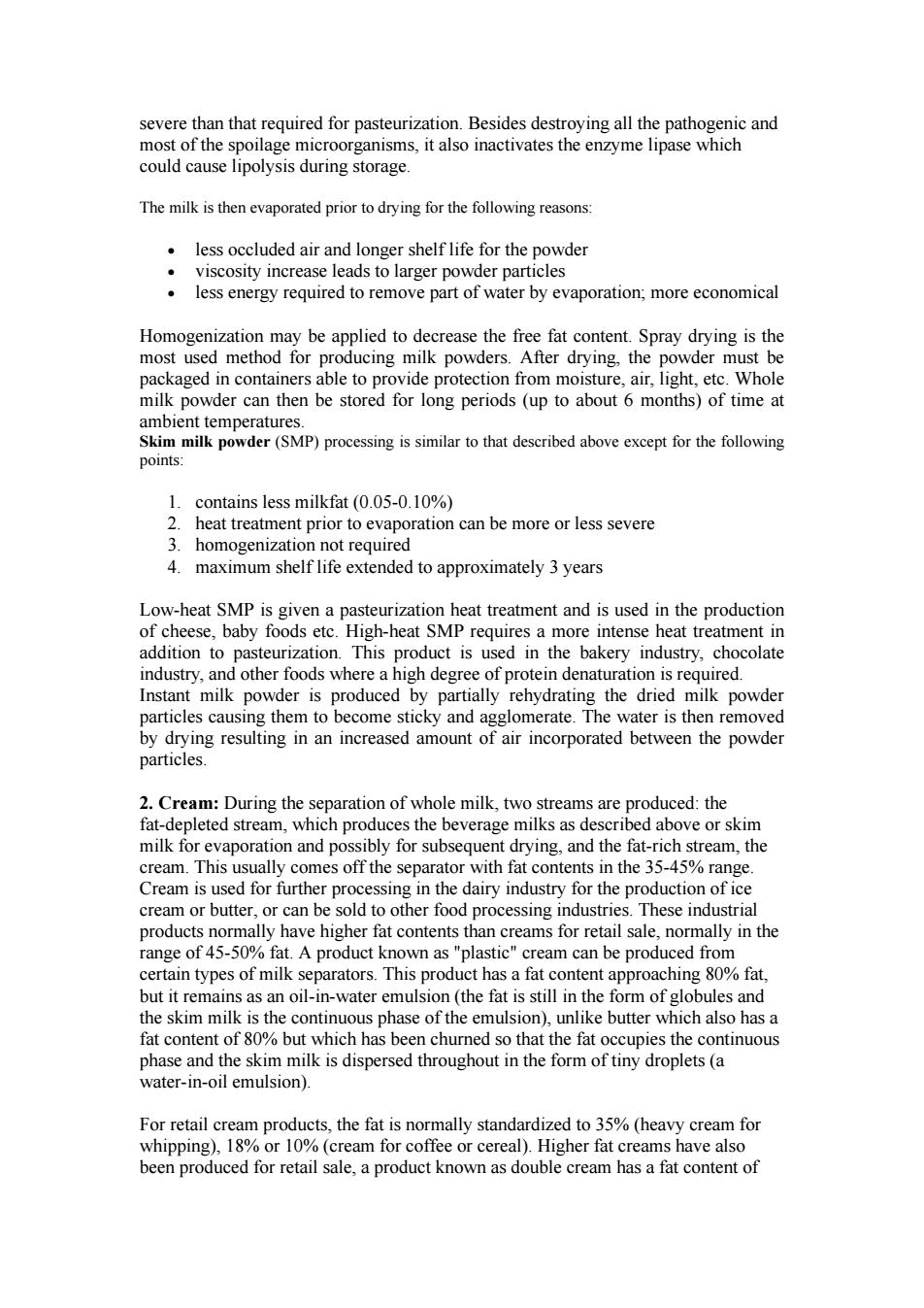正在加载图片...

severe than that required for pasteurization.Besides destroying all the pathogenic and most of the spoilage microorganisms,it also inactivates the enzyme lipase which could cause lipolysis during storage. The milk is then evaporated prior to drying for the following reasons less occluded air and longe rshelf life for the po wder ads ·l1 less ene emove pa evaporation,more economical Homogenization may be applied to decrease the free fat content.Spray drying is the most sed method for roducing milk nowders after d the wder must be packaged in containers able to provide protection from moisture.air,light,etc.Whole milk powder can then be stored for long periods (up to about 6 months)of time at ambient temperatures. Skim milk powder(SMP)processing is similar to that described above except for the following point 1.contains less milkfat (0.05-0.10%) 2.heat treatment prior to evaporation can be more or less severe 3.homogenization not required 4.maximum shelf life extended to approximately 3 years Low-heat SMP is given a pasteurization heat treatment and is used in the production of cheese,baby foods etc.High-heat SMP requires a more intense heat treatment in addition to pasteurization. This product is used in the bakery industry,chocolate industry,and other foods where a high degree of protein denaturatior is required. Instant milk powder is produced by parti ally rehydr ting the dried milk powde m to ecome s omerate.I of air incorporated between the powder 2.Cream:During g the of whole milk,two ced:the fat de ted s th ilks e or skim milk for evapor ration and po ssibly for subseq nt dr g.and the fat-rich stream.the cream This usually comes off the Cream is used for further processing in the dairy industry for the production of ice cream or butter,or can be sold to other food processing industries.These industrial megts5Xetowmcaimpanr certain types of milk separators.This product has a fat content approaching 80%fat, but it remal s as an oil-in-water emulsion (the fat is still in the form of globules and the skim milk is the continuous phase of the emuls on),unlike butter which also has a content een cnume that the fat occupies t continuous pnase anc ilk is dispersed throughout in the form of tiny droplets (a water-in-oil emulsion for retail crear products,the fat is normally standardized to 35%(heav eam for whipping),18%or 10%( ream for c offee o ereal).Higher fat c e also been produced for retail sale.a product known as double cream has a fat content ofsevere than that required for pasteurization. Besides destroying all the pathogenic and most of the spoilage microorganisms, it also inactivates the enzyme lipase which could cause lipolysis during storage. The milk is then evaporated prior to drying for the following reasons: • less occluded air and longer shelf life for the powder • viscosity increase leads to larger powder particles • less energy required to remove part of water by evaporation; more economical Homogenization may be applied to decrease the free fat content. Spray drying is the most used method for producing milk powders. After drying, the powder must be packaged in containers able to provide protection from moisture, air, light, etc. Whole milk powder can then be stored for long periods (up to about 6 months) of time at ambient temperatures. Skim milk powder (SMP) processing is similar to that described above except for the following points: 1. contains less milkfat (0.05-0.10%) 2. heat treatment prior to evaporation can be more or less severe 3. homogenization not required 4. maximum shelf life extended to approximately 3 years Low-heat SMP is given a pasteurization heat treatment and is used in the production of cheese, baby foods etc. High-heat SMP requires a more intense heat treatment in addition to pasteurization. This product is used in the bakery industry, chocolate industry, and other foods where a high degree of protein denaturation is required. Instant milk powder is produced by partially rehydrating the dried milk powder particles causing them to become sticky and agglomerate. The water is then removed by drying resulting in an increased amount of air incorporated between the powder particles. 2. Cream: During the separation of whole milk, two streams are produced: the fat-depleted stream, which produces the beverage milks as described above or skim milk for evaporation and possibly for subsequent drying, and the fat-rich stream, the cream. This usually comes off the separator with fat contents in the 35-45% range. Cream is used for further processing in the dairy industry for the production of ice cream or butter, or can be sold to other food processing industries. These industrial products normally have higher fat contents than creams for retail sale, normally in the range of 45-50% fat. A product known as "plastic" cream can be produced from certain types of milk separators. This product has a fat content approaching 80% fat, but it remains as an oil-in-water emulsion (the fat is still in the form of globules and the skim milk is the continuous phase of the emulsion), unlike butter which also has a fat content of 80% but which has been churned so that the fat occupies the continuous phase and the skim milk is dispersed throughout in the form of tiny droplets (a water-in-oil emulsion). For retail cream products, the fat is normally standardized to 35% (heavy cream for whipping), 18% or 10% (cream for coffee or cereal). Higher fat creams have also been produced for retail sale, a product known as double cream has a fat content of